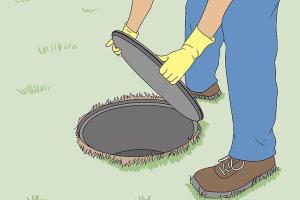Ultimate Guide: How to Unclog Your Septic Tank Effectively

-
Quick Links:
- Introduction
- Understanding Septic Tanks
- Signs of a Clogged Septic Tank
- Causes of Clogs
- Preventive Measures
- Step-by-Step Guide to Unclogging Your Septic Tank
- When to Call a Professional
- Case Studies
- Expert Insights
- FAQs
Introduction
Septic tanks play a crucial role in managing waste in homes not connected to municipal sewage systems. However, they can become clogged, leading to unpleasant odors, backups, and extensive damage. In this guide, we’ll explore how to unclog your septic tank effectively, with detailed steps, preventive measures, and expert insights.
Understanding Septic Tanks
A septic tank is a wastewater treatment system that consists of a tank and a drain field. Wastewater from the home flows into the tank where solids settle, and liquid effluent is filtered through the drain field. Understanding how your septic system functions is essential for effective maintenance and troubleshooting.
Components of a Septic Tank
- Inlet Pipe: Where wastewater enters the tank.
- Tank: Holds wastewater; allows solids to settle.
- Outlet Pipe: Releases treated effluent to the drain field.
- Drain Field: Filters and disperses effluent into the soil.
Signs of a Clogged Septic Tank
Identifying a clogged septic tank early can save you time and money. Here are common signs to look for:
- Slow draining sinks and toilets
- Backups in plumbing fixtures
- Unpleasant odors around the tank or drain field
- Pooling water in the yard
- Bright green grass over the drain field area
Causes of Clogs
Understanding the causes of septic tank clogs can help you prevent future issues:
- Excessive solids: Flushing non-biodegradable items.
- Grease buildup: Accumulation from kitchen waste.
- Tree roots: Infiltration into pipes.
- Low bacteria levels: Resulting from chemical cleaners.
Preventive Measures
Preventing clogs is easier than fixing them. Here are some effective measures:
- Regular pumping (every 3-5 years)
- Avoid flushing non-biodegradable items
- Limit grease disposal down the drain
- Plant trees away from the septic system
Step-by-Step Guide to Unclogging Your Septic Tank
When faced with a clogged septic tank, follow these steps to address the issue:
Step 1: Assess the Situation
Determine the extent of the clog. Check for visible signs of backup in toilets and drains. If backups are severe, it may indicate a more serious problem.
Step 2: Locate the Septic Tank
Identify the location of your septic tank by checking property records or using a metal detector to find the access ports.
Step 3: Pump the Septic Tank
Hire a licensed professional or rent a pump to remove the sludge and solids from the tank. This can resolve many clog issues.
Step 4: Inspect the Drain Field
After pumping, inspect the drain field for pooling water or strong odors, indicating more significant issues.
Step 5: Use Drain Cleaners Carefully
For minor clogs, consider using enzyme-based drain cleaners that are safe for septic systems. Avoid harsh chemicals that can disrupt the bacterial balance.
Step 6: Monitor Usage
After unclogging, monitor water usage to prevent future clogs. Implement preventive measures discussed earlier.
When to Call a Professional
If you experience persistent problems despite following the above steps, it’s time to consult a septic tank professional. They can diagnose and resolve complex issues.
Case Studies
Case Study 1: Homeowner Experiences Frequent Clogs
A homeowner in Texas faced persistent septic tank clogs every six months. After consulting a professional, they discovered excessive grease buildup from kitchen waste. After implementing a grease trap and regular pumping schedule, the issue was resolved.
Case Study 2: Tree Roots Causing Damage
Another homeowner in Florida noticed slow drainage and pooling water. A professional found that tree roots had infiltrated the pipes. They performed a root removal and recommended planting trees farther from the septic system.
Expert Insights
Experts recommend regular maintenance as the best way to prevent septic tank problems. According to the National Environmental Services Center, 30% of septic systems fail due to improper maintenance.
FAQs
1. How often should I pump my septic tank?
It is generally recommended to pump your septic tank every 3 to 5 years, depending on usage and size.
2. Can I use chemical drain cleaners in my septic system?
It is not advisable to use chemical drain cleaners as they can kill beneficial bacteria needed for septic function.
3. What are the signs my septic tank needs pumping?
Signs include slow drains, gurgling sounds in plumbing, and unpleasant odors around the tank.
4. How can I prevent septic tank clogs?
Avoid flushing non-biodegradable items, limit grease disposal, and schedule regular maintenance.
5. What should I do if I have a backup?
If you have a backup, stop using water immediately and call a professional to assess the issue.
6. Can tree roots damage my septic tank?
Yes, tree roots can infiltrate pipes and cause significant damage and clogs.
7. How do I locate my septic tank?
You can locate your septic tank by checking property records or using a metal detector to find access ports.
8. What is the average cost to pump a septic tank?
The cost can vary, but it typically ranges from $300 to $500 depending on location and tank size.
9. Can I fix a clogged septic tank myself?
Minor clogs can sometimes be addressed with enzyme cleaners, but it’s best to consult a professional for severe issues.
10. Is it safe to plant over a septic drain field?
It is best to avoid planting large trees or shrubs over the drain field, as roots can cause damage.
Random Reads
- Mastering number series generation in ms excel
- Mastering object unlocking indesign
- How to venetian plaster
- How to verify gpg signature
- How to paint aluminum siding
- How to paint designs on walls
- How to print mirror image
- How to make a free website using wix
- Mastering audacity
- Mastering auto numbering in excel